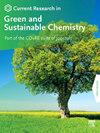用四丁基氯化铵作为绿色捕收剂从磷酸盐中选择性浮选硅酸盐
Q2 Materials Science
Current Research in Green and Sustainable Chemistry
Pub Date : 2025-01-01
DOI:10.1016/j.crgsc.2025.100461
引用次数: 0
摘要
介绍了四丁基氯化铵(TBAC)作为一种新型的选择性捕收剂在磷灰石-石英模型样品反浮选中的应用。采用Zeta电位测量、接触角分析、FTIR和x射线荧光光谱(XPS)研究试剂在矿物质-水界面的吸附。FTIR分析显示,在TBAC处理的石英中出现了与C-H和C-N拉伸相对应的新峰,而在磷灰石中没有,表明TBAC在石英表面的优先吸附。XPS分析进一步支持FTIR结果;经tbac处理的石英在401.5 eV处有明显的n1s峰,而磷灰石没有出现n1s峰,证实了两者之间没有明显的相互作用。Zeta电位测量结果显示,经过TBAC处理后,石英的表面电荷变化幅度大于磷灰石,特别是在较高的pH值下,石英在pH值11时的表面电荷变化幅度为+16.28 mV,而磷灰石的表面电荷变化幅度仅为+0.4 mV。接触角测量也表明,TBAC显著提高了石英的疏水性,达到115°以上的值,而磷灰石的变化很小。通过浮选试验,评价了TBAC作为磷灰石和石英捕收剂的性能。单矿物浮选中,当TBAC用量为150 g/t时,pH为11时石英回收率最高,达97%,磷灰石回收率降至31.6%。使用商用石英捕收剂,二元矿物体系的磷灰石回收率高达52.4%,而使用TBAC时,磷灰石回收率仅为25.3%。与传统DA捕收剂的对比试验表明,DA的磷灰石回收率(52.4%)明显高于TBAC(25.3%),强调了TBAC与磷矿物的有限相互作用及其在反浮选过程中去除硅酸盐的潜在用途。本文章由计算机程序翻译,如有差异,请以英文原文为准。
Selective flotation of silicates from phosphates using Tetrabutyl Ammonium Chloride as a green collector
This study introduces Tetrabutyl Ammonium Chloride (TBAC) as a novel selective collector for silicates in the reverse flotation of apatite-quartz model sample. Zeta potential measurements, contact angle analysis, FTIR, and X-ray fluorescence spectroscopy (XPS) were employed to investigate reagent adsorption at mineral-water interfaces. FTIR analysis revealed the appearance of new peaks corresponding to C–H and C–N stretching in TBAC-treated quartz, but not in apatite, indicating TBAC's preferential adsorption on quartz surfaces. XPS analysis further supported FTIR results; a distinct N 1s peak at 401.5 eV was observed on TBAC-treated quartz, while no such peak appeared on apatite, confirming the absence of significant interaction. Zeta potential measurements showed a larger shift in surface charge for quartz than for apatite after TBAC treatment, particularly at higher pH levels, with a notable shift of +16.28 mV at pH 11 for quartz, compared to only +0.4 mV for apatite. Contact angle measurements also demonstrated that TBAC significantly increased quartz hydrophobicity—reaching values above 115°—while apatite showed minimal change. Flotation tests were conducted to evaluate the performance of TBAC as collector for apatite and quartz. In single mineral flotation, the highest quartz recovery (97 %) was achieved at pH 11 with a TBAC dosage of 150 g/ton while the apatite recovery was reduced to 31.6 %. The binary-mineral system showed a higher recovery of apatite with a commercial quartz collector at 52.4 %, compared to just 25.3 % when TBAC was used. Comparative tests with a conventional DA collector revealed that apatite recovery was significantly higher with DA (52.4 %) than with TBAC (25.3 %), emphasizing TBAC's limited interaction with phosphate minerals and its potential utility for silicate removal in reverse flotation processes.
求助全文
通过发布文献求助,成功后即可免费获取论文全文。
去求助
来源期刊

Current Research in Green and Sustainable Chemistry
Materials Science-Materials Chemistry
CiteScore
11.20
自引率
0.00%
发文量
116
审稿时长
78 days
 求助内容:
求助内容: 应助结果提醒方式:
应助结果提醒方式:


